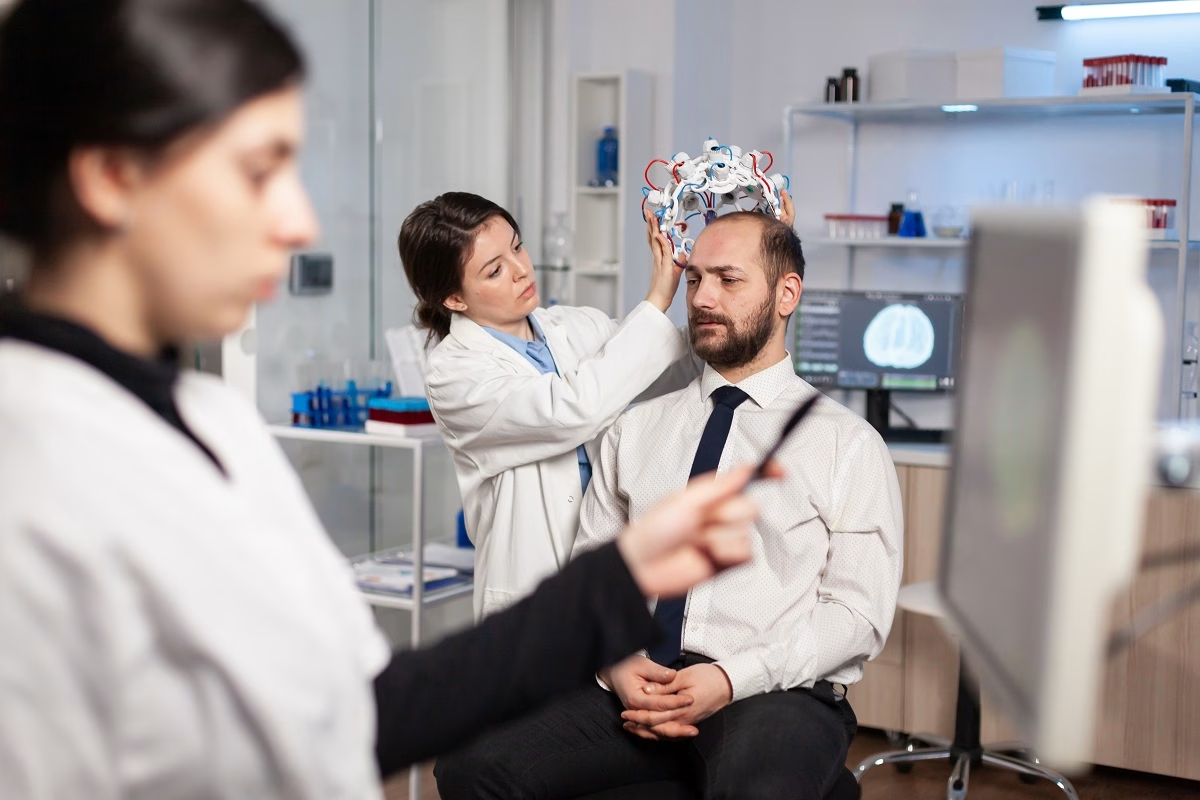A serious brain condition that often occurs when a person has seizures that last too long or occur too quickly is called status epilepticus (SE). Generally, all disorders that cause seizures put you at increased risk of developing SE. Despite being a dangerous condition, it is treatable, and most people survive and recover completely with immediate medical care. In most cases, people with epilepsy have seizures, but there are other conditions that may cause this symptom. It is important to understand that SE is a medical emergency, and without immediate treatment, it may lead to death.
If you or someone has a seizure that lasts more than 5 minutes, immediately call 911 or go to the nearest emergency room (ER).
In general, this condition is uncommon, but one of the most common brain-related medical emergencies. Healthcare providers estimate approximately 7 and 40 cases per 100,000 people every year. In the United States, between 23,000 and 130,000 people experience SE annually. Furthermore, roughly 2% of seizures turn into SE.
How Does Status Epilepticus Affect My Body?
This condition originates in the brain, but it also negatively affects multiple systems in the body. To better understand what this condition causes, it is important to know what a seizure is.
When the neurons cannot handle extended periods of uncontrolled activity, too much electrical current causes damage to the neurons. It occurs similarly to an electronic device that has an overload of electrical current.
Effects on the Body
This condition may cause widespread uncontrolled muscle movements throughout the body. During this period, the body temperature increases, and the muscles are tired out. Thereafter, the body tries to compensate for this process by producing and releasing certain chemicals in the blood that may help for a short time. When SE continues for too long, it may negatively affect the following systems and processes in the body. Examples include:
- Heart – The chemical changes that occur in the blood during SE may cause damage to the heart muscle instead of helping cope with the symptoms. In some cases, a person may develop arrhythmia (irregular heart rhythms) or bradycardia (slowed heart rate).
- Muscles – Continuous activity may cause damage to the muscles just as you overdo them during workouts. In severe cases, the muscle tissue may break down.
- Kidneys – Generally, the breakdown of muscles is toxic, and your kidneys can filter these toxins in limited amounts. An increased level of these toxins may lead to damage to the kidneys and even cause kidney failure.
- Breathing – This condition may negatively affect the way you breathe, which reduces oxygen levels in the blood. Moreover, some people may inhale fluids from the stomach into the lungs (also known as aspiration). This can lead to pneumonia and other infections.
- High body temperature – The body temperature may rise to dangerous levels when SE occurs. Therefore, it can cause damage to multiple systems throughout the body (including the brain).
Symptoms
Commonly, people experience different symptoms because it depends on where seizures occur in the brain. However, you can experience different types of seizures. Check below some examples:
- Convulsive SE – It involves uncontrollable shaking movements or convulsing on both sides of the body. The primary types of seizure that often turn into SE are generalized tonic-clonic seizures.
- Nonconvulsive SE – In such cases, a seizure occurs without uncontrollable movements or convulsions. However, some minor movements or repetitive movements can still happen involving a hand or a part of the face. Usually, focal seizures (such as absence seizures) cause nonconvulsive SE.
Causes
This condition occurs only due to seizures, and there are two primary ways in which it happens. For example:
- Acute symptomatic seizures (also known as provoked seizures) – These seizures occur due to underlying disorders or specific circumstances, including high fever, drug or alcohol withdrawal, reduced blood sugar, strokes, tumors, and encephalitis. Approximately 25% to 30% of all seizures are provoked. Moreover, a seizure that occurs after a brain injury is an acute symptomatic seizure that may turn into SE.
- Epileptic seizures (also called unprovoked seizures) – These seizures are not caused by a disorder or circumstance. They occur when a person’s brain produces spontaneous seizures. Usually, this type of seizure occurs several days after a specific cause, such as a stroke or head injury.
Specific Causes
Generally, there are multiple reasons that may cause seizures. Moreover, there are specific causes that significantly increase the risk of SE in children and older adults. These include:
- Fevers (especially very high) – The primary cause of seizures in children under 12 months of age is febrile seizures.
- Strokes, aneurysms, and brain hemorrhages – Any disorder that causes damage to the brain or negatively affects its function may cause a seizure. However, aneurysms and brain bleeds cause seizures more commonly in people over 60 years old.
However, seizures may also occur due to other reasons. Check below some of them:
- Brain tumors (including malignant ones)
- Cerebral hypoxia (lack of oxygen)
- Severe concussion and traumatic brain injury
- Degenerative brain disorders (such as Alzheimer’s disease, frontotemporal dementia, and others)
- Alcohol and drugs (for example, prescription medicines, recreational drugs, and even caffeine)
- Drugs and alcohol withdrawal
- Eclampsia (a disease in which hypertension may cause a seizure during pregnancy)
- Electrolyte imbalances (including reduced levels of Calcium, Magnesium, or Sodium)
- Certain genetic conditions
- Sensitivity to flickering or flashing light
- Hormonal changes
- Infections (including encephalitis or meningitis that may occur due to viruses, bacteria, or fungi)
- Inflammation caused by an autoimmune disorder
- Metabolic conditions (such as hypoglycemia or hyperglycemia)
- Congenital brain structure problems
- Sepsis
- Toxins and poisons (such as carbon monoxide or heavy metal poisoning)
Risk Factors
Seizures can happen to anyone who is under the right circumstances or has epilepsy. However, there are some factors that could increase your risk of developing it. These include:
- Age – There is an increased risk of developing SE in children under 12 months of age and older adults (over 60 years old). In general, their risk increases due to some health conditions that people in these age groups are more prone to this disorder.
- Sex – Men are slightly more likely to develop SE than women.
- Medical history of epilepsy – If you have a history of epilepsy, it also increases the risk of SE. Moreover, between 16% and 38% of children have a history of epilepsy, and in adults, between 42% and 50%.
- Drug toxicity
- Frequent seizures
- Encephalitis
- Misuse of alcohol or recreational drugs
- Hypoxia
- Stroke
- Brain tumors
- Head injuries or trauma
This document does not contain a complete list of factors that may increase your risk of SE.
What Are The Potential Complications of Status Epilepticus?
There are some complications that may occur in people who experience SE. However, treatments for SE may also cause some complications. Check below some examples:
- Mental health problems (including anxiety or depression)
- Memory loss
- Cardiac damage
- Aspiration pneumonia
- Respiratory failure
- Rhabdomyolysis
- Hyperthermia
- Low blood pressure (also known as hypotension)
- Metabolic disturbances
In any case, you can consult with your doctor about ways to reduce the risk of previous complications.
How to Prevent Status Epilepticus?
While seizures often occur unpredictably, there are some tips that may help reduce the risk of developing them. That’s why it is usually not possible to prevent seizures. Examples include:
- Rescue medicines – If you are diagnosed with a seizure disorder, you should have a “rescue” medicine all the time. For instance, Benzodiazepines in a nasal spray may help stop a seizure. If you notice that someone has a seizure, you should wait until it stops before giving the medication.
- Dietary changes – There are multiple health conditions related to circulatory and heart health (such as stroke) that may cause damage to the brain tissue, especially if you are over 60 years old. That’s why adopting a healthy diet is very important. It helps reduce the risk of certain health conditions and avoid seizures from electrolyte problems (such as reduced levels of Sodium in the blood).
- Treatment for infections – If you get an eye or ear infection, it is very important to get treatment as soon as possible because some infections can spread to the brain and cause high fevers.
- Safety equipment – You should wear protective equipment (including safety belts, restraints, and helmets) to prevent head injuries, which are a major cause of seizures.
- Avoid misuse of alcoholic drinks and recreational drugs – If you administer large amounts of alcohol or recreational drugs, it may lead to seizures.
- Manage chronic health conditions – It is also vital to get treatment for chronic health conditions, including type 2 diabetes, hypertension, and others.
Diagnosis
Usually, doctors diagnose SE based on the seizure symptoms and the time they last. However, it is essential to find the exact cause of seizures. Therefore, physicians may perform the following tests to determine the cause. For example:
- Electroencephalogram (EEG) – This is usually a primary test used in people who have had seizures. It also helps confirm status epilepticus.
- Blood tests – These tests are often done to check for metabolic and blood chemistry imbalances, immune system disorders, toxins and poisons, and others.
- Spinal tap (also known as lumbar puncture)
They may also perform some imaging tests, including CT (computed tomography) scans or MRI (magnetic resonance imaging) scans, to get detailed images of multiple tissues and organs in the body. In such cases, imaging tests are done to get detailed images of the brain and nearby structures.
Treatment
Usually, to treat SE, doctors may prescribe a combination of treatments. It often includes medicines, intubation, treatment for the underlying cause, supportive treatments, and others.
Medicines
The following medicines are the primary option to stop a seizure. Moreover, they can treat some complications caused by status epilepticus (such as arrhythmia). Check below the most common prescribed medicines for a person with SE:
- Benzodiazepines – These medications help limit the electrical activity in the neurons, which often interrupts a seizure. It comes in different forms, including injections, nasal sprays, tablets, and others.
- Antiseizure medicines – This group of medications works similarly to Benzodiazepines. Usually, these medications are given to the patients intravenously (IV).
- General anesthesia – In severe cases, physicians use anesthesia to put a person in a medically induced coma. It helps protect the brain and body from further damage caused by SE.
Intubation
This treatment option involves a tube that is inserted down the patient’s trachea. It helps keep the windpipe open. Therefore, it allows the doctor to use manual resuscitation bags or a ventilator to breathe.
Antiseizure Options
The following treatments are used to prevent further seizures, which help prevent SE. Check below the most common options recommended by doctors:
- Epilepsy surgery
- Dietary changes (including low-carb or no-carb ketogenic diets)
- Nervous system stimulation (such as vagus nerve stimulation, deep brain stimulation, and others)
Frequently Asked Questions
How soon after treatment will I feel better?
The recovery time often depends on multiple factors. The most important of them include how long SE lasts, response to treatment, overall health, age, and others. Usually, doctors tell their patients the timeline for recovery.
How long does status epilepticus last?
In most cases, SE lasts at least 5 minutes. When it lasts more than the previous time, SE can be fatal.
When should I go to the ER?
In general, this condition is a medical emergency that requires immediate treatment. Otherwise, it may lead to death. If you or someone else has a seizure, immediately call 911 or go to the nearest emergency room (ER). Ask your healthcare professional if you have any other questions.




